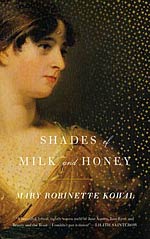
![]() FeminineFantastique
FeminineFantastique
2/23/2014
![]()
Mary Robinette Kowal's Shades of Milk and Honey, the first in her Glamourist Histories series, is a fantasy homage to Jane Austen, though this story provides less social commentary on Regency-era England than a portrait of the relationship between sisters.
While the plot of this novel strikes chords of familiarity with Austen's Pride and Prejudice, the protagonist Jane Ellswood and her sister Melody evoke Sense and Sensibility's Elinor and Marianne Dashwood, who are pragmatic and passionate by turns. Charming and impulsive Melody gives into flights of fancy, and her prudent older sister Jane guards her heart so fiercely that she has trouble seeking her own happiness. In Shades of Milk and Honey, Melody is piqued by her sister's far greater talent for glamour — the magic with which one creates a home, a feature of marriageability that Kowal adds to Austen's fictional landscape. Jane believes that her skill is all she has to offer, for her dowry is meager and she lacks the vivacity and beauty of her younger sister.
And thus, it is the heartbreaking insecurity of these young women that brings the tale into modern relevance. I cried with Jane when she overheard tittering mockery of her appearance at a ball; I ached for Melody when she believed herself too shallow and insubstantial to attract notice. The sisters' envy, their bitter rifts and loving reconciliations, echo timelessly.
The men drift in and out of the story — taciturn Mr. Vincent, enigmatic Captain Livingston, kind Mr. Dunkirk — leaving less of an impression than the novel's sympathetic women. This is not as much of a problem as it could be, though; for in this story, the self-rescuing protagonist, rather than her suitors, saves the day. Unlike Elizabeth Bennett of Austen's Pride and Prejudice, the heroine is not only present at the story's climax, but plays an active role in its resolution. When the villains are revealed as villainous — for all is not what it seems, of course — it is Jane who removes the masks and reveals the truth, and Jane who risks her safety for love.
Magic plays a subtle role in the story but intertwines through the setting, the plot, and the romance. Glamour, a technique of magic that can create sensory images — from the scent of wildflowers on the breeze to a tableau vivant, a moving picture play — is not only a domestic art. It is used to enhance, or to obfuscate. Through glamour art is created and love is expressed. Through glamour, people nearly die, and people learn how to live.
But in the end, it is not glamour that bewitches us or the characters, but the joie de vivre of finding beauty in the ordinary.
http://manicpixiedreamworlds.wordpress.com/